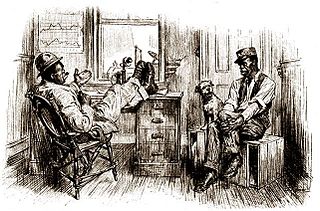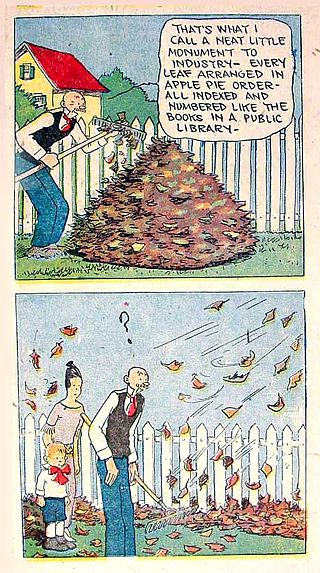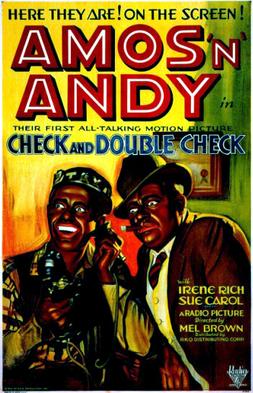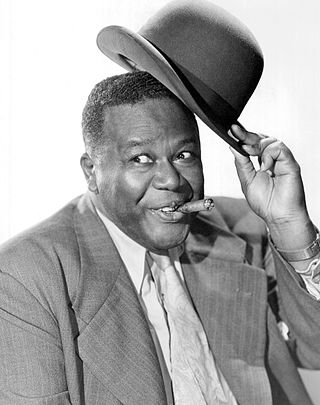Autograph Records was an American record label in the 1920s owned by Marsh Laboratories of Chicago, Illinois, which was owned by Orlando R. Marsh, an electrical engineer.

Amos 'n' Andy is an American radio sitcom about black characters, initially set in Chicago and later in the Harlem section of New York City. While the show had a brief life on 1950s television with black actors, the 1928 to 1960 radio show was created, written and voiced by two white actors, Freeman Gosden and Charles Correll, who played Amos Jones (Gosden) and Andrew Hogg Brown (Correll), as well as incidental characters. On television, 1951–1953, black actors took over the majority of the roles; white characters were infrequent.

Charles James Correll was an American radio comedian, actor and writer, known best for his work in the radio series Amos 'n' Andy with Freeman Gosden. Correll voiced the main character Andy Brown, along with various lesser characters.

Freeman Fisher "Gozzie" Gosden was an American radio comedian, actor and pioneer in the development of the situation comedy form. He is best known for his work in the radio series Amos 'n' Andy.

WGN is a commercial AM radio station in Chicago, Illinois, featuring a talk radio format. WGN's studios are in the Chicago Loop, while the transmitter is in Elk Grove Village. WGN also features broadcasts of Chicago Blackhawks hockey and Northwestern University football and basketball.

The Gumps is a comic strip about a middle-class family. It was created by Sidney Smith in 1917, launching a 42-year run in newspapers from February 12, 1917, until October 17, 1959.

Calvin and the Colonel is an American animated sitcom about Colonel Montgomery J. Klaxon, a shrewd fox, and Calvin T. Burnside, a dumb bear. Their lawyer was Oliver Wendell Clutch, who was a (literal) weasel. The colonel lived with his wife Maggie Belle and her sister Susan Culpepper, who did not trust the colonel at all. Colonel Klaxon was in the real estate business, but always tried get-rich-quick schemes with Calvin's unwitting help.

Check and Double Check is a 1930 American pre-Code comedy film produced and released by RKO Radio Pictures, based on the Amos 'n' Andy radio show. The title was derived from a catchphrase associated with the show. Directed by Melville W. Brown, from a screenplay by Bert Kalmar, J. Walter Ruben, and Harry Ruby, it starred Freeman Gosden and Charles Correll in blackface, in the roles of Amos Jones and Andy Brown, respectively, which they had created for the radio show. The film also featured Duke Ellington and his Cotton Club Orchestra.

Spencer Williams was an American actor and filmmaker. He portrayed Andy on TV's The Amos 'n' Andy Show and directed films including the 1941 race film The Blood of Jesus. Williams was a pioneering African-American film producer and director.

WSCR – branded as 670 The Score – is a commercial sports radio station licensed to serve Chicago, Illinois, servicing the Chicago metropolitan area and much of surrounding Northern Illinois, Northwest Indiana and parts of the Milwaukee metropolitan area. Owned by Audacy, Inc., WSCR is a clear-channel station with extended nighttime range in most of the Central United States and part of the Eastern United States. WSCR serves as the Chicago affiliate for the BetQL Audio Network, CBS Sports Radio, the Fighting Illini Sports Network and the NFL on Westwood One Sports; the flagship station for the Chicago Cubs and Chicago Bulls radio networks; and the home of radio personalities David Haugh and Matt Spiegel.

Robert Sidney Smith, known as Sidney Smith, was the creator of the influential comic strip The Gumps, based on an idea by Captain Joseph M. Patterson, editor and publisher of the Chicago Tribune.
The year 1926 saw a number of significant happenings in radio broadcasting history.
Elizabeth McLeod is a journalist and broadcast historian who lives and works on the coast of Maine. She is best known for her extensive research into the origin and history of Amos 'n' Andy, an authoritative study first available on the Internet and then in her book, The Original Amos ’n’ Andy: Freeman Gosden, Charles Correll and the 1928–1943 Radio Serial.
Orlando R. Marsh was an electrical engineer raised in Wilmette, Illinois. In early 1920s Chicago, Illinois he pioneered electrical recording of phonograph discs with microphones when acoustic recording with horns was commonplace. His firm Marsh Laboratories, Inc., founded in 1922, at one time was located on the seventh floor of the Lyon & Healy Building near the corner of Wabash and Jackson in Chicago. The Marsh firm no longer exists but the building still stands and is part of DePaul University.(1)
William Gibiral Hay was an American radio announcer who was famous for his many years of work on the Amos 'n' Andy show with Charles Correll and Freeman Gosden.

Barbara Jean Wong was an American actress, primarily on the radio.

The term "Dialect comedy" was coined by David Marc in his essay, Origins of the genre. Dialect comedies are a genre of radio sitcoms that were popular between the 1920s and the 1950s. They relied on the exaggerated and highly stylized portrayal of stereotypes, usually based on ethnic humor. The genre has its roots on the vaudeville stage and in the minstrel shows that became popular in the 19th century. The ethnicities of the actual actors portraying the dialects did not have to match the characters; while much Jewish dialect comedy was created and portrayed by actual Jews, other dialect comedies, such as those involving blackface, were often not.
The Gumps is an American radio sitcom broadcast from 1931 until 1937, mostly on CBS Radio based on the popular Sidney Smith newspaper comic strip The Gumps. It was the first radio adaptation of comics.

Judith Cary Waller was an American broadcasting pioneer. Despite the fact that she knew nothing about radio at the time, she became the first station manager of Chicago radio station WMAQ when it went on the air in 1922. She was one of the first female radio station managers in the United States, along with Eleanor Poehler of WLAG and WCCO in Minneapolis, and Bertha Brainard of WJZ in New York. During her tenure as station manager, Waller was responsible for obtaining broadcast rights for Chicago Cubs home games for WMAQ and for hiring Freeman Gosden and Charles Correll as Amos 'n' Andy after they left WGN radio over syndication rights. Waller tried to interest the CBS radio network in the program with no success. NBC brought the program to its Blue Network three years before its purchase of WMAQ in 1931.
Elinor Harriot was an American actress who became active in education and civic affairs after she left acting.













